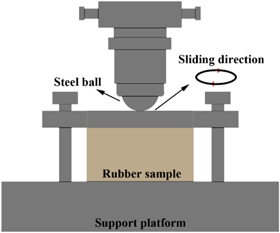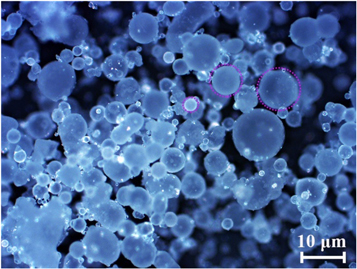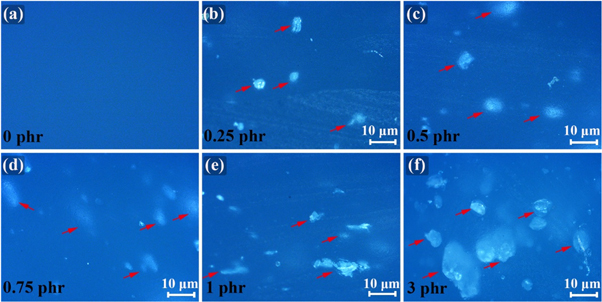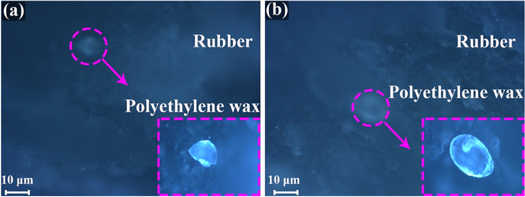Abstract
As an auxiliary agent for rubber processing, polyethylene wax can be used to enhance the diffusion of filler in rubber, improve the extrusion speed of rubber compound and facilitate rubber demoulding, which has good development potential in the field of rubber processing and manufacturing. At present, there is no research on the optimum amount of polyethylene wax in silicone rubber. Therefore, in this paper, we studied the influence of different amount of polyethylene wax on the mechanical and friction properties of silicone rubber. Firstly, silicone rubber composites with different polyethylene wax content were prepared by mechanical mixing and hot pressing. Then, the mechanical properties and friction and wear properties of silicone rubber composites were tested by tensile testing machine and multifunctional comprehensive tester for surface properties of materials. Finally, combined with a series of characterization methods, such as three-dimensional (3D) morphology, scanning electron microscopy (SEM), microscopic observation and energy dispersive X-ray spectroscopy (EDS), the mechanism of polyethylene wax in silicone rubber was studied. The results show that the best addition amount of polyethylene wax in silicone rubber is 0.25 phr, and the friction coefficient of polyethylene wax/silicone rubber composite is the lowest and most stable, and the wear amount is the least. In the process of friction, polyethylene wax can be separated from silicone rubber matrix and distributed on the surface of wear marks, playing a better role in lubrication and wear reduction.
Export citation and abstract BibTeX RIS

Original content from this work may be used under the terms of the Creative Commons Attribution 4.0 licence. Any further distribution of this work must maintain attribution to the author(s) and the title of the work, journal citation and DOI.
1. Introduction
Silicone rubber has excellent aging resistance, electrical insulation, temperature resistance, high permeability, etc. Therefore, it is widely used in aerospace, automobile industry, medical and health care, outdoor insulation and other fields [1–8]. We all know that abrasion resistance is a very important index for evaluating rubber products [9], especially in terms of silicone rubber seals [10]. The poor wear resistance of rubber composites limits its application. In recent years, there have been some reports on enhancing the wear property of silicone rubber composite materials. Zheng et al [11] found that adding 2.0% graphene material to silicone rubber could effectively improve its tensile and tearing properties, while adding 0.75% graphene material could make its wear resistance reach the best, and analyzed the lubrication and wear reduction mechanism of graphene in silicone rubber composites. He et al [12] studied the effects of adding different amounts and kinds of silica on the mechanical and tribological properties of silicone rubber composite materials. Besides, It had been reported in literature that adding jatropha oil during the friction process of silicone rubber composite materials could play a excellent lubricating role [13]. However, it is inevitable that we should consider the production cost and source of materials. Hence, it is necessary to find cheap functional additives.
Polyethylene wax is also known as low molecular weight polyethylene, which has excellent mechanical properties, lubrication, wear resistance, anti-settling properties, electrical properties, chemical stability and demodulatory properties [14, 15]. It is often applied to plastic products, coatings, masterbatch processing, printing ink, wax products and rubber production [16–19]. At present, the research on polyethylene wax mainly focuses on adhesion and coating. Kostyuk et al [20]. used polyethylene wax as a substitute for mineral filler to add to pressure sensitive adhesive, and the addition of polyethylene wax significantly improved the shear resistance, durability and strength of adhesive. In addition, polyethylene wax not only has low cost, but also can reduce the viscosity of adhesive, which is more conducive to the low-cost and efficient manufacture of adhesive. Tian et al [21]. grafted polyethylene wax with maleic anhydride effectively improved the bonding performance between Ultra-high molecular weight polyethylene (UHMWPE) fiber and resin interface. In addition, Tian et al [22]. found that grafting polyethylene wax with methyl methacrylate, then treating UHMWPE fiber alone or cooperating with silane coupling agent can improve the bonding strength between UHMWPE fiber and resin and improve the interfacial adhesion. Niu et al [23] treated wood surface with polyethylene wax grafted with methyl methacrylate. Compared with beeswax, it has lower price and better adhesion with wood, which can improve the thermal stability and hydrophobicity of wood. Marzbani et al [24] added polyethylene wax to soy protein isolate (SPI) to obtain SRI/polyethylene wax mixed coating. The research shows that adding polyethylene wax to the coating can reduce its viscosity. Besdies, compared with the paperboard without polyethylene wax coating, adding polyethylene wax will reduce the tensile strength of paperboard, but will improve the water resistance, surface wettability and water vapor permeability of paperboard.
Polyethylene wax can reduce the force between polymer molecules and play the role of internal lubricant. Adding polyethylene wax into rubber as internal lubricant can improve the fluidity of ozone resistance of rubber composite and enhance the dispersion of filler in rubber [25]. Moreover, it can also make rubber easier to demould. However, if it is added improperly during use, it will seriously affect the properties of rubber [26]. However, there are no reports on the application of polyethylene wax in silicone rubber and the effect of the content of polyethylene wax on the mechanical and friction properties of silicone rubber composite materials. In this paper, the mechanical and tribological behaviors of the polyethylene wax/silicone rubber composite materials are tested by using cheap polyethylene wax via a simple preparation process of rubber composites. The polyethylene wax/silicone rubber composite materials are investgated by means of 3D morphology, SEM , material microscope, etc. It provides reliable experimental basis for the correct use of polyethylene wax in silicone rubber composites.
2. Experimental procedure
2.1. Materials
Mixed silicone rubber (NE-5150) was purchased from Xinhong Plastics Co., Ltd. (China). Vulcanizing agent (HC-14) was received from Huahong rubber and plastic materials Co., Ltd. (China). Polyethylene wax (FM-800A) was provided from Fumei technology development Co., Ltd. (China). Table 1 shows some detailed information of the above materials. All materials were used as they were received.
Table 1. Materials information.
| Materials | Introduction |
|---|---|
| Silicone rubber | Brand: NE-5150, the compound contains white carbon black and silicone oil |
| Vulcanizing agent | Brand: HC-14, main components: peroxide, anti-yellowing agent and other additives, using temperature: 170 ̃ 220 °C |
| Polyethylene wax | Brand: FM-800A, softening point 108 °C, molecular weight 3000 g mol−1. |
2.2. Preparation of sample
Polyethylene wax/silicone rubber composites were prepared via mechanical mixing and hot-pressing processes. Firstly, the silicone rubber was placed on mixing mill (Lina Industrial (Mechanical) Co., Ltd. (China)). Then vulcanizing agent and polyethylene wax were added, respectively. After mixing the filler evenly, the raw rubber sheet was obtained. Finally, the raw rubber sheet was vulcanized via a plate vulcanizer (LN-50T, Lina Industrial (Mechanical) Co., Ltd. (China)), the curing conditions were 175 °C, 5 MPa, for 8 min The size of the as-prepared rubber sheet was 140 mm × 120 mm × 2 mm. The diameter and height of the as-prepared cylindrical rubber block in the friction test were 28 mm and 12 mm, respectively. The fabrication process was shown in figure 1. It should be noted that there were six kinds of polyethylene wax/silicone rubber composite samples (A, B, C, D, E and F), when the silicone rubber was 100 phr and the vulcanizing agent was 1.6 phr, the addition amount of polyethylene wax was 0 phr, 0.25 phr, 0.5 phr, 0.75 phr, 1 phr, 3 phr, respectively (see table 2).
Figure 1. Flow chart of fabrication of polyethylene wax/silicone rubber composite materials.
Download figure:
Standard image High-resolution imageTable 2. The type of polythene wax/silicone rubber.
| Sample | Silicone rubber (phr) | Vulcanizing agent (phr) | Polyethylene wax (phr) |
|---|---|---|---|
| A | 100 | 1.6 | 0 |
| B | 100 | 1.6 | 0.25 |
| C | 100 | 1.6 | 0.5 |
| D | 100 | 1.6 | 0.75 |
| E | 100 | 1.6 | 1 |
| F | 100 | 1.6 | 3 |
2.3. The performance test
The mechanical properties of the samples were tested by the tensile tester (SMT-5000, Saisi testing equipment co., Ltd. (China)). The tensile test of rubber samples was carried out according to the standard of ISO 37:2005, and the tensile rate was 500 mm min−1. The hardness of rubber samples was tested according to the standard of ISO 7619-1:2004, and the thickness of the sample was 6 mm, and each sample was tested at different positions for 5 times. The friction testing machine (CFT-I, Yanhua science and technology. (China)) was employed to test the friction properties of polyethylene wax/silicone rubber composite materials at room temperature (25 °C), The method of rotating friction was adopted, the load was 10 N, the rotating radius was 5 mm, the rotation speed was 200 rpm, and the time was 60 min The diameter of the GCr15 steel ball in contact with the surface of silicone rubber during friction is 5 mm, the friction test diagram is shown in figure 2. To calculate the mass loss of the sample during wear, the samples were weighed via an electronic balance (accuracy 0.0001 g) before and after the friction experiment. Nitrogen was used to clean the surface of the sample before weighing. The average friction coefficient of each curve was denoted as the friction coefficient of the sample.
Figure 2. The diagram of rotating friction test.
Download figure:
Standard image High-resolution image2.4. Sample characterization
The shape and size of polyethylene wax powder were observed with a study grade microscope (Axio Scope A1, Carl Zeiss (Germany)). In addition, the profile and wear surface of silicone rubber composites were characterized. A three-dimensional surface topography instrument (ST-400M, NANOVEA (U.S.A.)) was used to measure the wear characteristics of the sample. Scanning electron microscopy (NOVA NANOSEM 450, Thermo Fisher Scientific (U.S.A.)) was employed to further observe the microscopic morphology of the wear marks on the surface of the samples. Since rubber is non-conductive, it must be sprayed with gold before SEM observation. The spraying voltage is 20 kV and the spraying time is 90 s. The types and contents of elements on the surface of wear marks were analyzed via EDS (NOVA NANOSEM 450, (U.S.A.)).
3. Results and discussions
3.1. Characterization of polyethylene wax
The polyethylene wax was observed via the microscope as shown in figure 3. The magnification of the microscope is 100 times. We found that the polyethylene wax particles were round and had different sizes. The minimum particle diameter can reach less than 1 μm and the maximum diameter can exceed 10 μm. Otherwise, the diameter of polyethylene wax particles can be roughly divided into three types (refer the pink circle in figure 3): 2.5 μm, 6.0 μm and 9 μm.
Figure 3. Microscopic view of polyethylene wax powder.
Download figure:
Standard image High-resolution image3.2. Mechanical properties
The mechanical behaviors of the polyethylene wax/silicone rubber composite materials were tested via a tensile tester. Figure 4 shows the tear strength, elongation at break and tensile strength of silicone rubber composites with different polyethylene wax contents. From the figure 4, we can observe that the tear strength and tensile strength of silicone rubber composite materials decrease with the increase of the content of polyethylene wax. When the addition of polyethylene wax is 0.25 phr and 3 phr, the tensile strength of silicone rubber composites decreases by 13.7% and 36.3%, and the tear strength decreases by 5.5% and 18.5%, respectively. Therefore, we can draw the conclusion that the tear strength and tensile strength of silicone rubber composite materials can be reduced by the addition of micron-grade polyethylene wax. Obviously, the tensile strength is relatively affected by polyethylene wax. The above phenomenon may be due to the fact that polyethylene wax does not participate in the crosslinking reaction of silicone rubber, not only does not improve the matrix strength of silicone rubber, but also has the effect of reducing the matrix strength of silicone rubber. At the same time, the decrease of the matrix strength of silicone rubber has a great influence on its tensile strength. This phenomenon is similar to the micro-zone plasticization of rubber oil with high aromatic hydrocarbon content in rubber matrix [27]. With the increase of polyethylene wax content, the plasticization of polyethylene wax in silicone rubber matrix is more serious, and the influence on the properties of silicone rubber matrix is greater.
Figure 4. Mechanical behaviors of polyethylene wax/silicone rubber composite materials.
Download figure:
Standard image High-resolution imageNevertheless, the elongation at break of polyethylene wax/silicone rubber composites is different from that of tensile strength and tear strength. When the amount of polyethylene wax is added from 0.25 phr to 3 phr, the elongation at break of silicone rubber composite materials has experienced a process of first decreasing and then increasing. When the polyethylene wax is added 0.25 phr, the elongation at break only decreases by 0.3%, so the elongation at break is almost unaffected by the polyethylene wax. When the amount of polyethylene wax is 1 phr, the elongation at break of polyethylene wax/silicone rubber composite materials decrease to the lowest. When 3 phr polyethylene wax are added, the elongation at break of polyethylene wax/silicone rubber composite materials increase by 10.2% compared to neat silicone rubber. When the addition amount of polyethylene wax increases from 0.25 to1 phr, the matrix strength of silicone rubber is reduced, so the elongation at break of silicone rubber composite materials gradually decrease. However, when the content of polyethylene wax increases to 3 phr, because polyethylene wax melting occurs in the process of silicone rubber vulcanizing, the vulcanization of silicone rubber is hindered seriously, the matrix of silicone rubber is reduced greatly. As a result, silicone rubber becomes soft and is easier to be stretched, so the elongation at break of silicone rubber is distinctly increased, and even exceeds that of the neat silicone rubber.
3.3. The properties of friction and wear
Figure 5 displays clearly the variation curve of friction coefficient versus time in the friction process of silicone rubber composites with different polyethylene contents. By combining with figures 5(d) and 6(a), it can be found that with the increase of polyethylene wax, the friction coefficient of polyethylene wax/silicone rubber composites from decreases to increases, then decreases and finally increases. Besides, when the amount of polyethylene wax is 0.25 ̃ 1 phr, the friction curve of silicone rubber composite materials is relatively stable, indicating that polyethylene wax plays a lubricating role during the friction process. When the addition of polyethylene wax is 0.25 phr, the friction coefficient of polyethylene wax/silicone rubber composite materials is the most stable and minimum. On the contrary, when the content is 3 phr, the friction curve appears the phenomenon of stepped rise, the friction coefficient is the highest, and the lubricating effect of polyethylene wax is the worst.
Figure 5. Curves of friction coefficient versus time (each sample was tested three times). (a) The amount of polyethylene wax is 0 phr and 0.25 phr. (b) The amount of polyethylene wax is 0.5 phr and 0.75 phr. (c) The amount of polyethylene wax is 1 phr and 3 phr. (d) Friction curves of polyethylene wax/silicone rubber composite materials.
Download figure:
Standard image High-resolution imageFigure 6. (a) The variation of friction coefficient and wear amount of polyethylene wax/silicone rubber composite materials with different content of polyethylene wax. (b) The hardness of polyethylene wax/silicone rubber composite materials varies with the amount of polyethylene wax.
Download figure:
Standard image High-resolution imageFigure 6(a) displays that the wear amount of silicone rubber composite materials first decreases and then increases with the increases of polyethylene wax, indicating that the content of polyethylene wax for 0.25 phr can enhance the wear performance of silicone rubber composites. Figure 6(b) illustrates that the hardness of silicone rubber composites can be reduced by adding polyethylene wax. When the addition amount increases from 1 phr to 3 phr, the hardness of polyethylene wax/silicone rubber composite materials decreases sharply. As it can be found in figure 4, the tear strength and tensile strength of polyethylene wax/silicone rubber composite materials are also reduced, it can be concluded that the matrix strength of polyethylene wax/silicone rubber is significantly reduced when the amount of polyethylene wax is 3 phr. During the friction process, the steel ball is more easily to cause serious damage to the matrix of polyethylene wax/silicone rubber, which increases the roughness of the surface of the abrasion mark, so the friction coefficient and the wear mass increase.
In order to study the effect of adding polyethylene wax of different amount on wear property of silicone rubber composites, the wear marks are quantitatively analyzed by three-dimensional noncontact surface topography. Figure 7 is the contour map of wear marks of polyethylene wax/silicone rubber composites. The maximum sag height (Sv) first drops and then rises, while the maximum crest height (Sp) has no obvious rule.
Figure 7. Contour map of wear marks of polyethylene wax/silicone rubber composite materials.
Download figure:
Standard image High-resolution imageWhen the amount of polyethylene wax is 0.25 phr, both Sv and Sp are the smallest. Moreover, the numerical difference between Sv and Sp is also the smallest. To some extent, it indicates that the substrate of silicon rubber composites is destroyed in the friction process and the surface roughness of wear marks is the lowest. Therefore, when the amount of polyethylene wax is 0.25 phr, the friction coefficient of polyethylene wax/silicone rubber composite materials is the lowest and the wear amount is the minimum.
3.4. Analysis of optical microscopic
The profiles of polyethylene wax/silicone rubber are observed via a research-grade material microscope. The difference between polyethylene wax and silicone rubber is found under microscope, so the dispersion of polyethylene wax in silicone rubber can be clearly observed. The polyethylene wax in silicone rubber matrix shows obvious agglomeration when the amount of polyethylene wax increases. Since the softening point of polyethylene wax is 108 °C, while the temperature during the vulcanization of polyethylene wax/silicone rubber is 175 °C and the pressure is 5 MPa, so the polyethylene wax will melt during the vulcanization of the polyethylene wax/silicone rubber composite materials. If the polyethylene wax particles are close to each other, the polyethylene wax particles melt under pressure may come into contact. polyethylene wax will exist in the matrix of silicone rubber composite materials in the form of microcrystals when the silicone rubber composite materials are cooled at room temperature. Therefore, when the amount of polyethylene wax is large, the polyethylene wax will accumulate in the matrix of polyethylene wax/silicone rubber (as shown in figure 8(f)).
Figure 8. The profile of polyethylene wax/silicone rubber composites (50 x), and all samples were observed after silicone rubber vulcanization.
Download figure:
Standard image High-resolution imageFigure 9 exhibits the polyethylene wax particles on the surface of wear scar. The microscopic analysis was performed in reflection mode. It can be seen from figure 9(a) that polyethylene wax particles are half-coated on the surface of wear scar of silicon rubber composites. According to figure 9(b), it is found that polyethylene wax particles are exposed on the surface of wear scar of silicon rubber composites. It indicates that the polyethylene wax particles in the silicone rubber composites matrix are separated during the friction process and exist on the surface of wear scar. Polyethylene wax particles play the role of external lubrication and reduce the friction coefficient and the amount of wear.
Figure 9. The polyethylene wax particles on the surface of wear scar (a) Polyethylene wax particles are semi-coated inside the rubber matrix, (b) Polyethylene wax particles are fully coated in the rubber matrix.
Download figure:
Standard image High-resolution image3.5. Analysis of SEM
Scanning electron microscopy is used to further observe the microstructure of the surface of wear scar. Silicone rubber is non-conductive, and the samples need to be sprayed with gold before scanning electron microscopy, so there is no obvious difference between polyethylene wax particles and the rubber matrix in the scanning electron microscopy pictures. As shown in figures 10(a) and (b), there is basically no difference in the microstructure between the surface of wear scar of polyethylene wax (0.25 phr)/silicone rubber composite materials and the surface of wear scar of polyethylene wax (0 phr)/silicone rubber composite materials. However, with the increase of the amount of polyethylene wax, especially when the amount increased from 0.5 phr to 3 phr, the decrease of matrix strength of polyethylene wax/silicone rubber leads to the gradual increase of the damage degree of the friction surface. The increase of damage degree is mainly manifested as the wear pattern, the increase of pits and holes, and the formation of larger grinding debris.
Figure 10. Surface wear trace micrograph of silicone rubber composites with different components of polyethylene wax added.
Download figure:
Standard image High-resolution image3.6. Analysis of EDS
In this paper, we select polyethylene wax/silicone rubber composite materials that the amount of polyethylene wax is 0 phr and 0.25 phr for elemental analysis. It can be found from figure 11 that the amount of carbon element on the surface of the wear scar increases after the addition of polyethylene wax for 0.25 phr. The content of carbon element in polyethylene wax is relatively high when the quantity of silicone rubber composite materials and polyethylene wax is the same. Therefore, the content of carbon element increases after the addition of polyethylene wax for 0.25 phr. It can be seen clearly in figures 11(a) and (b), there are only carbon, oxygen and silicon elements, indicating that no impurities are introduced during the preparation of polyethylene wax/silicone rubber composite materials. By comparing figures 11(c) and (d), it is found that the distribution of carbon element on the surface of silicon rubber composites is still uniform when the amount of polyethylene wax is 0.25 phr. This proves that the polyethylene wax is dispersed evenly on the surface of the wear scar during the friction process, which makes the polyethylene wax can play a great lubricating role.
Figure 11. (a) Energy spectrum of silicone rubber composites with 0 phr of polyethylene wax. (b) Energy spectrum of polyethylene wax/silicone rubber composites with 0.25 phr of polyethylene wax. (c) Carbon element distribution of silicone rubber composite materials when the amount of polyethylene wax is 0 phr (corresponding to the figure 11(a)). (d) Carbon element distribution of polyethylene wax/silicone rubber composite materials when the amount of polyethylene wax is 0.25 phr (corresponding to the figure 11(b)).
Download figure:
Standard image High-resolution image4. Conclusions
In a word, in this paper, silicone rubber composites with different polyethylene wax content were obtained by conventional rubber mixing and vulcanization process. The influence of polyethylene wax on the mechanical and friction properties of silicone rubber composites was investigated by SEM, three-dimensional morphology, microscope and other material characterization methods. Some main conclusions were as follows:
By comparing the effects of polyethylene wax with different content on the tensile strength, elongation at break, friction coefficient and wear loss of silicone rubber composites, it was finally determined that the best addition amount of polyethylene wax as a rubber additive in silicone rubber was 0.25 phr. Interestingly, when the amount of polyethylene wax is 3 phr, compared with pure silicone rubber, its elongation at break is increased by 10.2%. When the content of polyethylene wax is 0.25 phr, the polyethylene wax can be stripped from the rubber matrix, dispersed to the friction surface, and play a certain role in lubrication and friction reduction, thus reducing the friction coefficient and wear of silicone rubber composites, and making silicone rubber have a relatively stable friction coefficient.
Acknowledgments
The authors gratefully acknowledge the financial support of the project of China Special Equipment Inspection and Research Institute (grant no.2021qingnian11).
Data availability statement
All data that support the findings of this study are included within the article (and any supplementary files).
Conflicts of interest
The authors declare no conflict of interest.












